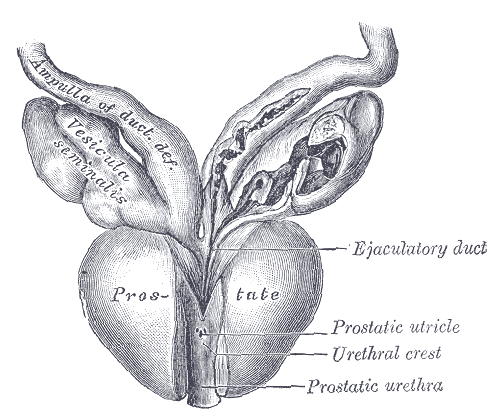The word prostate has its roots in the Greek word prostates which means “one who stands before,” “protector,” or “guardian.” This may be due to its position to the front of the gallbladder. The Greek word was not used for the organ we now know as the prostate. In fact, it wasn’t a medical term but may have been the origin of the words “President” and “principal.” It would take centuries before a form of this word would be used for a part of the body. Use of the term “prostate” may have been used earlier than we thought, predating written evidence we have today.
Niccolo Massa was the first to make notations about the prostate while performing anatomy dissections in 1532. Massa published his observations in the book Liber Introductorius Anatomiae, an anatomy textbook. In it, he describes in the inner workings of the human body in great detail. Massa makes a very brief reference to the prostate but does not call it by that name.
Andreas Vesalius’s book, De Humani Corporis Fabrica published in 1543, has a more detailed description of the prostate. These early writings did not accurately portray how the prostate worked nor its actual purpose. They recorded merely speculation at this point, with some interesting ideas of how the prostate worked.
1600 may have been when the first actual use of the word prostate is found in a document. French physician Andre Du Laurens used a version of the word, “prostatae” in his book Historia Anatomica Humani Corporis. This is the wrong gender ending to the word, but it was used that way due to an error in interpreting the prostates composition and function. They were trying to find a name that identified it as doubled. It would take centuries before this error would be considered incorrect and a consistent term is adopted.
I found surprisingly little information about the prostate between the 17th century and the 19th. It’s not until the 19th century that you start to see more written evidence. Jean Cruveilhier, a French physician and anatomist who has several diseases to his name, wrote about the prostate in the early 19th century. Later in the century, Leo Testut would also write about the prostate. They seem convinced the prostate consisted of several lobes. Jean Cloquet and Marie Philibert Constant Sappey described it as a unique zone.
When we get into the 20th century, Joaquin Albarran described the sub-urethral glands in 1902. Bernard Joseph Cuneo wrote about the prostate in 1911, Oswald S Lowsley in 1912, Gil Vernet in 1953 then LM Franks, in 1954. John McNeal wrote about the prostate in 1968 and 1978. He had established that the prostate is histologically and anatomically heterogeneous. It has three zones, transitional, central and peripheral ones. McNeal not only mapped the structure of the prostate he is also known for pioneering prostate cancer pathology.
One big issue I found while trying to look up the origin of the term prostate is that it’s hard to say exactly when the term got its start. Most write-ups about the word credit du Laurens as the first to use the term as prostatae. Another abstract refutes this and says that other anatomists and physicians knew of the prostate’s existence as early as Herophilus of Alexandria in the 300s BC. Herophilus is credited as being the first anatomist, so it is possible he was the earliest person to write about the prostate. Often the prostate was described as a glandular assistant. Despite being looked at in cadavers for centuries, it was only until the mid 20th century that prostate cancer was fully mapped out, and ways to improve prostate health became a priority.
It’s interesting to see how long it took for doctors to uncover the mystery of “guardian” of the gall bladder. Now we have a whole month devoted to the prostate as September designated as National Prostate Health Month. Not bad for a walnut-sized gland that does more for your health than just provide an alkaline fluid for sperm.


